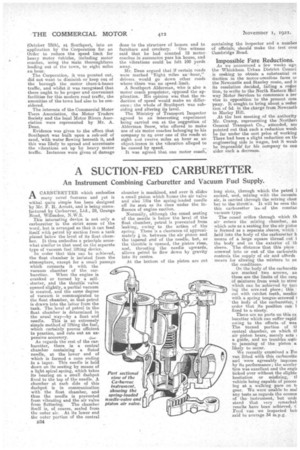A SUCTION-FED CARBURETTER.
Page 24

If you've noticed an error in this article please click here to report it so we can fix it.
An Instrument Combining Carburetter and Vacuum Fuel Supply.
ACARBURETTER which embodies many novel features and yet is withal quite simple has been designed by Mr. F. H. Arnett, and is being manufactured by Carburvac, Ltd., 28, Grange Road, Willesden, N.W.2.
This interesting device is not only a carburetter in the strict sense of the word, but is arranged so that it can feed itself with petrol by suction from a tank placed below the level of its float chamber. It thus embodies a principle somewhat similar to that used on the separate type of vacuum fuel lifting device.
In order that this can be achieved, the float chamber is isolated from the atmosphere, except for a small passage which connects it with the vacuum chamber of the carburetter. When the engine is cranked or turned by a selfstarter, and the throttle: valve opened slightly, a partial vacuum is created, and the same degree of vacuum is communicated to the float chamber' so that petrol is drawn into the latter from the tank. The level of petrol in the float chamber is determined in the usual way—by a float and needle. This is an extremely simple method of lifting the fuel, which certainly proves efficient in practice, and cuts out an expensive accessory.
As regards the rest of the carburetter, there is a central chamber containing a fluted needle, at the lower end of which is farmed a cone ending in a taper. This needle is held down on its seating by means of a light spiral spring, which takes its bearing on a small dashpot fixed to the top of the needle. A chamber at each side of this dashpot is in communication with the float chamber, and thus the needle is prevented from vibrating and the air valve from fluttering. The chamber itself is, of course, sealed from the outer air. At, its lower end the outer portion of the central 1134 chamber is machined, and over it slides a, small piston which forms the air valve and also lifts the spring-loaded needle off its seat, as its rises under the. influence of engine suction.
Normally, although the coned seating of the needle is below the level of the float chamber, petrol is prevented from leaking, owing to the action of the spring. There is a clearance of approximately in. between the air piston and the tapered end of -the needle, but, as the throttle is opened, the piston rises, and, thrusting the needle upwards, allows petrol to flow down by gravity into its centre.
At the bottom of the piston are cut long slots, through which the petrol i sucked, -and, mixing with the incomin air, is carried through the mixing chair her to the throttle. It will be seen ths this carburetter is t•of the constan vacuum type.
The coned orifice through which tb air enters the mixing chamber, an which seta as a seating for the air pistol(
is formed as a separate sleeve, which i held into the body of the carburetter b
means of a large square thread cuti the body and on the exterior of th sleeve. The distance that this piece : screwed into or out of the carburetta controls the supply of air and affords means for altering the mixture to en the conditions.
On the body of the carburetta are marked two arrows, an these are the limits of the rang of mixtures from weak to stroll which can be achieved by turi lug the sere xed piece; this cut with ratchet teeth, meshin with a spring tongue-screwed 1 the body of the carburetter, i order that its_ position can I fixed to a, nicety.
There are no parts on this ea buretter which can suffer rapid
owing to the effects of wee The turned portion of tl central chamber, on which ti air piston bears, merely acts / a guide, and no troubles. oath to jamming of the piston a likely to occur.
We recently examined a VOI van fitted with this carburette
and were agreeably impress( by its performance; the acceler tion was excellent and the engii ticked over without the slighte hesitation or misfiring, tl vehicle being capable of procee big at a walking pace on t( gear. We were unable to ma] any tests as regards the econon of the instrument, but uncle stand that very remarkat results have been achieved, t] Ford van we inspected beii said to average 34 m.p.g.
































